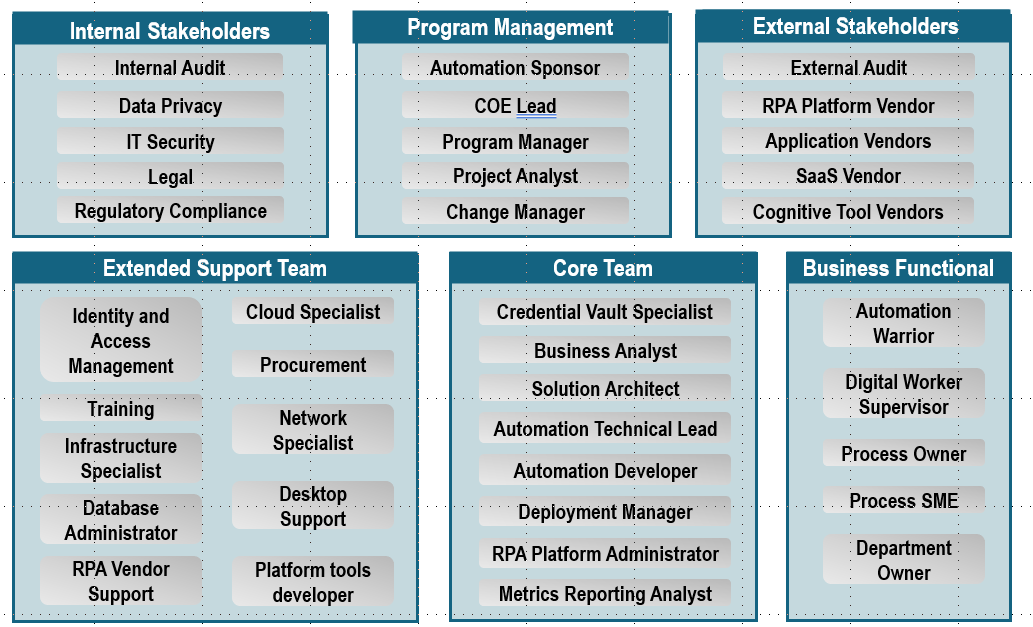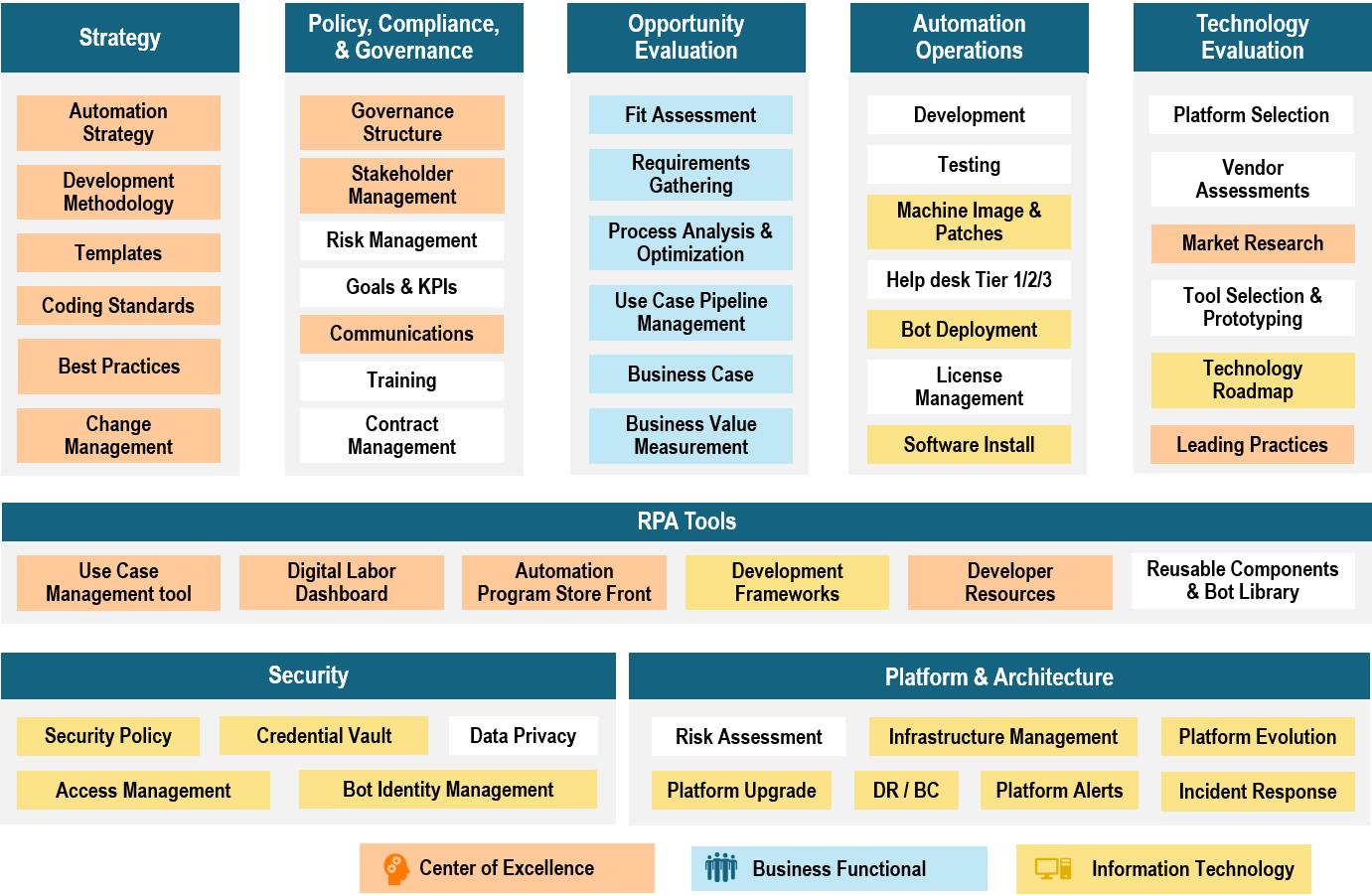Talking about roles and responsibilities seems like an obvious area of focus. Establishing expectations of skills, expertise, and responsibilities is one of the most basic rules of creating a functional team. Generally, these discussions center on the responsibilities and tasks a particular role should handle. Discussed less often is why this matters.
In the context of RPA, it’s important to spend time understanding what types of skills will be needed to successfully enable the capabilities you expect to own within your program and what will be handled by stakeholders. Developing a strategy for how you will acquire those skills should entail whether you already possess employees with the necessary knowledge and skills, or whether you’ll train existing employees to fill these new roles.
Seeking outside help is an option, but consider developing your existing staff for the responsibilities that will live beyond the initial program establishment. Bringing in a consultant is an excellent way to leapfrog competitors and accelerate your progress early on, but the ideal situation is to set yourself up for long-term success by developing a skilled team to help operate the program. Then, leverage outside resources with specialized skills to enhance the program as you grow. This model is often successfully used within finance, as modern finance function effectiveness is now heavily derived from the value RPA can bring.
Roles and Responsibilities are the Foundation of Accountability
It is worth investing extra time to develop well-defined roles catered for robotics, which may entail creating new job titles with a brand new set of RPA-centric duties. One of the most common oversights we see companies make is that they fail to account for the importance of dedicated resources focused on supporting and enabling the automation program, both within the Center of Excellence and within the business teams who own the bots. One thing program owners can do to increase the odds of success is to work closely with stakeholders to set well-defined expectations of what everyone will be responsible for, and translate them into a set of clearly defined tasks.
Automation Organization Role Areas

Compared with traditional systems, RPA is unique in that process owner involvement is more important to the success of bot operations. This is a critical point since many process owners may not be accustomed to playing such an active role in both conceiving the idea, and running the day-to-day automated processes. However, a key to success is to have process owners serve as the first line of defense on monitoring bots. We have found that this business-focused commitment may require new job descriptions that don’t currently exist within your organization. While RPA is new, companies should anticipate the need for support from various teams that support older technologies. This is necessary to ensure that there is a stable operation in place.
This graphic illustrates the various roles within a mature automation program, and shows how they are organized between the various stakeholder groups. While there are many traditional positions depicted on the chart, many of these roles will include new responsibilities requiring RPA-specific skills. One such position is a Digital Worker Supervisor. Serving as the first line of support, their primary role is to manage the bots and ensure that the business process is not interrupted when the bot “calls in sick.”
Automation Roles

As RPA begins to play an increasing role in more critical business functions, such as the monthly accounting close, treating the bot platform as a mission critical system will be prudent to ensure that the flow of business remains uninterrupted.
Identify the Roles
A good way to start with defining the staffing needs of your program is to examine the list of capabilities you identified when developing your plan. This list that you intend to enable within the program, and broadly throughout the organization, will point you to the roles you will need to staff.
Here, we illustrate the capabilities of a mature automation program. However, your program will focus on those capabilities that you start with and address the resources needed in order to deliver those starting focus areas.
Mature Automation Program

For example, if you are planning to complete custom training to augment the free online training from your RPA platform vendor, you will need a professional learning and development resource who can help you design and deliver this program in an effective manner. However, if you feel this is not a critical area to support internally, you can plan to bring in help to address your training needs.
An example of this approach would be:
- Evaluate each capability and identify those you plan to support.
- Establish an owner for each capability, including whether you plan to deliver it with external help.
- Document the list of responsibilities, tasks, skills, and deliverables and how those may align to a role.
- Examine your existing employee base to find those who either possess the necessary skills and experience, or have transferable skills and an interest in automation.
Once you identified the basic set of foundational capabilities and the roles necessary to support these functions, you can turn your focus to addressing any areas that are unique to your organization. Beyond the common core of capabilities, every program will have a unique set of challenges that will dictate where the focus needs to be to drive success.
However, take your time plugging these in as you have the capacity to focus your attention to defining them, and roll them out in a well-planned manner. Get the program running smoothly, and this will free you up to successfully build on that foundation rather than rushing from one fire drill to another.
If you are always addressing urgent issues because you are not staffed appropriately for success, this will create dissatisfaction with stakeholders, ding your credibility, and not allow you enough time and space to figure out how to effectively build your program. Ultimately, start off with a basic approach. There will be certain key roles that will enable your program in the early phases. Focus on establishing those first, and that will provide you with the ability to carry out the most common and important things needed to operate.